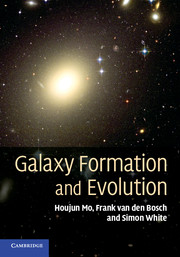Book contents
- Frontmatter
- Contents
- Preface
- 1 Introduction
- 2 Observational Facts
- 3 Cosmological Background
- 4 Cosmological Perturbations
- 5 Gravitational Collapse and Collisionless Dynamics
- 6 Probing the Cosmic Density Field
- 7 Formation and Structure of Dark Matter Halos
- 8 Formation and Evolution of Gaseous Halos
- 9 Star Formation in Galaxies
- 10 Stellar Populations and Chemical Evolution
- 11 Disk Galaxies
- 12 Galaxy Interactions and Transformations
- 13 Elliptical Galaxies
- 14 Active Galaxies
- 15 Statistical Properties of the Galaxy Population
- 16 The Intergalactic Medium
- A Basics of General Relativity
- B Gas and Radiative Processes
- C Numerical Simulations
- D Frequently Used Abbreviations
- E Useful Numbers
- References
- Index
8 - Formation and Evolution of Gaseous Halos
Published online by Cambridge University Press: 05 June 2012
- Frontmatter
- Contents
- Preface
- 1 Introduction
- 2 Observational Facts
- 3 Cosmological Background
- 4 Cosmological Perturbations
- 5 Gravitational Collapse and Collisionless Dynamics
- 6 Probing the Cosmic Density Field
- 7 Formation and Structure of Dark Matter Halos
- 8 Formation and Evolution of Gaseous Halos
- 9 Star Formation in Galaxies
- 10 Stellar Populations and Chemical Evolution
- 11 Disk Galaxies
- 12 Galaxy Interactions and Transformations
- 13 Elliptical Galaxies
- 14 Active Galaxies
- 15 Statistical Properties of the Galaxy Population
- 16 The Intergalactic Medium
- A Basics of General Relativity
- B Gas and Radiative Processes
- C Numerical Simulations
- D Frequently Used Abbreviations
- E Useful Numbers
- References
- Index
Summary
So far we have concentrated on the formation of structure under the influence of gravity alone. However, since the astronomical objects we are able to observe directly are made of baryons and electrons, the role of gas-dynamical and radiative processes must also be taken into account in order to understand how the structures we observe form and evolve. As demonstrated in §4.1.3, since baryons and dark matter are expected to be well mixed initially, the density perturbation fields of the baryons, δb, and dark matter, δdm, are expected to be equal in the linear regime, except for perturbations on scales smaller than or comparable to the Jeans length of the gas. In this chapter, we examine the role of gas-dynamical and radiative processes for the evolution of structures in the highly nonlinear regime. We start in §8.1 with a brief description of the basic dissipational processes. §8.2 describes the structure of gas in hydrostatic equilibrium within dark matter halos. The formation of gaseous halos in the absence of cooling and heating is discussed in §8.3, while §8.4 focuses on the impact of cooling. §8.5 describes several thermal and hydro dynamical instabilities of cooling gas, and §8.6 discusses the evolution of gaseous halos in the presence of energy sources. §8.7 gives a summary of the current status of numerical studies of the formation and structure of gaseous halos, while §8.8 discusses observations of gaseous halos associated with clusters and galaxies.
- Type
- Chapter
- Information
- Galaxy Formation and Evolution , pp. 366 - 416Publisher: Cambridge University PressPrint publication year: 2010

